Design Thinking and Innovation
- TOP PAGE
- Design Thinking and Innovation
Cultivating Entrepreneurial Talent to Create Innovation
Compared to many other countries, Japan was mired in the economic doldrums for 20 years from the start of 1990s. This time period is known as Japan's “Lost 20 Years.” Many industries could not figure out a growth strategy, and entrepreneurial talent was needed for them to create innovation. However, entrepreneurial skills cannot be learned through classroom lectures and experiments alone. RDC collaborates with society and businesses, pursuing learning through problem-solution.
Technology alone cannot spur innovation; it must be combined with design and business. At RDC we carry out problem-based learning (PBL) to cultivate entrepreneurial talent—i.e. education that combines technology, design, and business.
Rigid adherence to the scientific systems thinking of yesterday has revealed its limitations as a means of generating innovation. What is needed today to break through those limitations—and the educational method we have introduced—is design thinking. To work on indistinct problems that previous methodologies could not solve, we have adopted an approach used by designers, viz. a repetitive three-step cycle —observation, idea generation, and prototyping/verification. The solutions worked out in this way are given expression through storytelling. This is an idea-generating method for coming up with solutions that has applicability for a wide range of fields. This is not a technology-driven or market-driven approach, but a human-centered approach.
Design thinking has already started to be used in education at prestigious universities around the world. Many venture businesses emerge from these universities, as well as new products and services, not to mention talented individuals who are capable of creating innovation.

